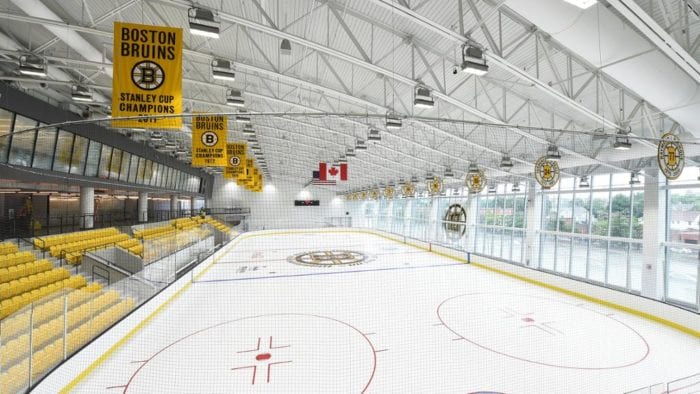
“The industry as a whole is very big, and it affects a lot of people. It’s not just the players and owners of the teams.”
Banners honoring Stanley Cup championships hung over a concrete slab. Operations Manager Jason Piche, at 6’9”, strode through the Bruins’ practice facility. Ducking into his office filled with paraphernalia from the Bruins’ longtime rivals, the Montreal Canadiens, Piche began his day at the empty and iceless arena.
Reduced schedules and economic hardships have been a common result of the COVID-19 pandemic. Social restrictions forced the fast-paced atmosphere of Warrior to come to a crashing halt, but staff members found a silver lining. Piche used the time to make Warrior better than ever before, finding sanctuary from the troubles of society in the deserted arena.
Upon realizing the shutdown wouldn’t end quickly, back in April staff turned off the compressors, allowing the ice to melt. Piche, sporting clothes covered in old paint, navigated through the soaking rink. Although messy, removing the ice saved thousands of dollars in energy costs, he said.
Prior to the pandemic, Warrior, which was completed in 2016, shut down for a week at most. This gave the crew enough time to change the ice, refreshing any cloudy paint sandwiched between slabs. Variables, like whether the rink shuts down for extended periods, determine how often the ice is changed. Most rinks that remain open year-round probably change the ice about every two to five years, depending on budgets and other conditions, Piche said.
Without ice to care for, the staff had plenty of time for side projects like painting. “The building looks better now than it did before we opened,” Piche said.
The ice returned to Warrior by early June, and NHL games are now anticipated to begin Aug 1. However, with more than 20 NHL players testing positive for COVID-19, the environment and prospects are constantly changing.
Meanwhile, staff at arenas worldwide are adapting to and readying restrictions while awaiting the return of sports. Workers at arenas and within the industry have suffered job losses. Many of these same people often live paycheck to paycheck. According to an ESPN-commissioned analysis that assumed “the NBA and NHL cancel the rest of their regular seasons and the playoffs are staged without fans … and that youth sports resume by July,” the pandemic could “erase nearly $371 million in wages—approximately 20 million hours—for ticket takers, beer vendors and other stadium and arena employees. At least $2.2 billion of national TV revenue would be lost, as well as up to $2.4 billion in tourism related to youth sports.”
“There’s definitely a ripple effect of those sporting events that a lot of people don’t think about,” Piche said. “They’re like, Well, we don’t really need sports. People don’t need to do that. But the industry as a whole is very big, and it affects a lot of people. It’s not just the players and owners of the teams.”

A history of maintenance
A love of Canadiens hockey didn’t propel Piche into the field of ice maintenance. His journey began with a girlfriend and her father. The father, who was a Zamboni driver at the University of Vermont, got Piche interested in sports maintenance. Although Piche began working mostly on the basketball courts, he had aspirations for the highest-paying gig, the rink.
“Every time there was a game and I wasn’t working, I was over there trying to learn stuff from them and pick up as much as I could,” Piche said.
To earn a certified ice technician designation, Piche completed three courses: ice maintenance and equipment operation, ice making and painting technologies, and basic arena refrigeration (or BAR for short).
When hockey was still underway in February, under the watchful cardboard-poster eyes of Bruins stars Brad Marchand and Patrice Bergeron, Piche studied a chart littered with numbers, evaluating data at ice level. The numbers affect how staff treat the ice. Warrior strives for one and a quarter inches over the concrete base layer.
The industry of ice maintenance has evolved since Piche began. “There used to be a lot of the old guard, where people guarded what they knew and had for tips and tricks,” he said. Although cancelled this year due to COVID-19 concerns, an annual conference now connects ice rink professionals from teams across North America. “When you go to one of these conferences, you know everyone there is in on it. It’s great because you can just talk, and everybody gets what you’re talking about.”
When Piche caught a Bruins game at TD Garden, which he often did, he looked at the ice. Watching the resurfacer, Piche studied and, to a degree, critiqued the ice maintenance pattern. Although Piche identified the pattern as unusual, each building has protocol specific to its technology and needs, so he couldn’t truly judge the crew’s work. More than anything else, in the field of ice maintenance, it’s important to remain alert and informed about variables like ice level and temperature.
“You’ve got to be paying attention to what’s going on,” Piche said. “Know if you’re cutting too much.”
More than a rink
In the midst of the pandemic, just before this article went to print, Piche called to tell me that he accepted a position as senior operations manager with a company out of Austin. He has two weeks at Warrior and then he’s gone; in the meantime, simple day-to-day tasks have remained in place at Warrior throughout the pandemic, some of which are personal.
When Piche first moved to Boston, he didn’t have a washer-dryer. His boss offered the facility’s machines, primarily used for the arena’s towel services, for Piche’s personal use with the caveat that he bring his own detergent. With the pandemic still in play, Piche continues to do his laundry at Warrior, which is a second home of sorts. It’s too bad that he’s leaving; the team here has embraced Piche, including his love of the Canadiens.
“At first, I was really nervous to even have a [Canadiens] pin in my pocket when I was interviewed,” Piche said. “But I got to the point where I now have decorated my office in it, and I’ll wear a shirt to work.”
Marissa Trott, facility manager at Warrior, found the anti-fan the perfect candidate for the job.
“Hiring fans of other teams seems ideal because then we wouldn’t have to worry about them stalking the players or doing anything inappropriate,” she said. “It’s turned into something fun for us here. We joke a lot about it.”
When the Bruins beat the Canadiens, Trott and other Warrior staff poke fun at Piche and his team. “But he’s always got those stats from the beginning of the NHL that show that they have more cups than we do,” Trott said.
At public events, Piche’s layers sometimes conceal the fabric of foes. When the Bruins played the Blues in the Stanley Cup finals last year, Warrior hosted a viewing party. Under a jacket, he was sporting a Blues shirt.
“If the Bruins won, then I would have to hang that banner up in the rafters that said, ‘Stanley Cup Champions.’” Piche laughed. “I didn’t want that.”
Nor did he want to see the industry on such thin ice.
“The income coming back is the biggest part of sports,” Piche said. “Yeah, we miss it from an entertainment standpoint, but the economy needs it.”
This article was produced in collaboration with the Boston Institute for Nonprofit Journalism as part of its Pandemic Democracy Project.
HELP DIGBOSTON WEATHER THIS STORM AND CONTINUE PROVIDING ARTICLES LIKE THIS ONE
Mikayla Heiss is a writer interested in science and sports. She is currently a graduate student in journalism at Boston University.

